Vue Spring Boot实现Excel上传 使用Vue+Spring Boot实现Excel上传功能
Daniel_D 人气:01.使用Vue-Cli创建前端项目
运用vue-cli工具可以很轻松地构建前端项目,当然,使用WebStorm来构建会更加简洁(如图)。本文推荐使用WebStorm,因为在后续开发中,IDE会使我们的开发更加简洁。部分配置如图:

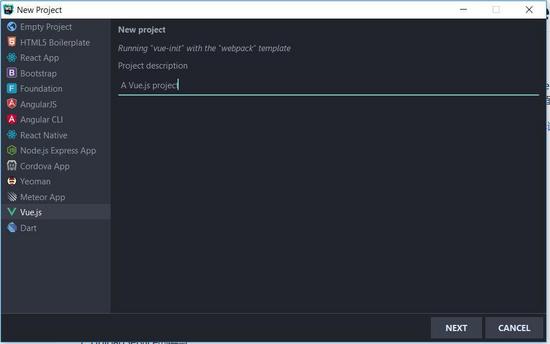
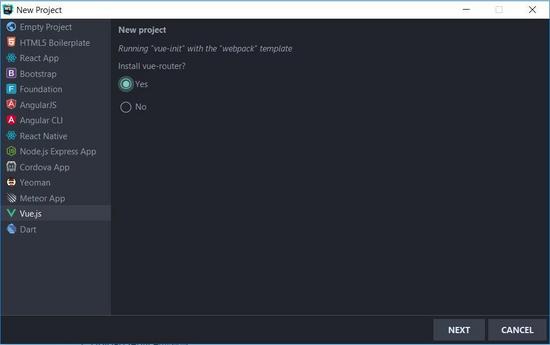

2.Navbar编写
作为一个WebApp,Navbar作为应用的导航栏是必不可少的。在本项目中,笔者引入了bootstrap对Navbar进行了轻松地构建。在vue中我们需要在components文件夹中将我们的组件加进去,对于本工程来说,Navbar是我们要加入的第一个组件,他独立于router之外,一直固定在网页上方。
2.1 首先,我们使用npm来安装vue,vue-cli,bootstrap
npm install vue npm install -g vue-cli npm install --save bootstrap jquery popper.js
2.2 接下来我们在components目录下new一个vue组件,并且在main.js中引入bootstrap依赖:
import 'bootstrap/dist/css/bootstrap.min.css' import 'bootstrap/dist/js/bootstrap.min'
2.3 下面就可以开始写代码了,由于本文只关注table相关的功能,所以导航栏中除了Script意外的元素都已经disable,代码如下:
<template>
<nav class="navbar navbar-expand-lg navbar-dark bg-dark">
<span class="navbar-brand mb-0 h1">Vue-SpringBoot</span>
<button class="navbar-toggler" type="button" data-toggle="collapse" data-target="#navbarNav" aria-controls="navbarNav" aria-expanded="false" aria-label="Toggle navigation">
<span class="navbar-toggler-icon"></span>
</button>
<div class="collapse navbar-collapse" id="navbarNav">
<ul class="navbar-nav">
<li class="nav-item">
<router-link class="nav-link" to="/home">Home</router-link>
</li>
<li class="nav-item active">
<router-link to="/" class="nav-link">Script</router-link>
</li>
<li class="nav-item">
<router-link to="/history" class="nav-link">History</router-link>
</li>
</ul>
</div>
</nav>
</template>
<script>
export default {
name: "MyNavbar"
}
</script>
<style scoped>
</style>
2.3 在App.vue中引入MyNavbar
3.Script Table编写
作为自动化工具,必不可少的一部分就是引入Script,我们希望用户能够自由地使用H5界面进行Script的编写,因此在这里使用了vue的数据双向绑定进行Table CRUD。
3.1 新建一个vue组件ScriptTable,代码如下:
<template>
<div class="container-fluid" id="scriptTable">
<h3>My Script</h3>
<form style="margin-top: 1rem">
<input type="file" @change="getFile($event)" class="" multiple/>
<input type="button" value="upload" @click="submit($event)" class="btn btn-dark">
</form>
<table class="table table-hover text-center table-bordered"
style="word-break: break-all; word-wrap: break-word;margin-top: 1rem;">
<thead>
<th>#</th>
<th>Platform</th>
<th>Action</th>
<th>Path</th>
<th>Value</th>
<th>Wait</th>
<th>Screenshot</th>
<th>Change</th>
</thead>
<tbody>
<tr v-cloak v-for="(item, index) in steps">
<th>{{index+1}}</th>
<td>{{item.platform}}</td>
<td>{{item.action}}</td>
<td>{{item.path}}</td>
<td>{{item.value}}</td>
<td>{{item.wait}}</td>
<td>{{item.screenshot}}</td>
<td><a href="#" v-on:click="edit(item)">Edit</a> | <a href="#" v-on:click='aaa(index)'>Delete</a>
</td>
</tr>
<tr>
<th></th>
<td><select class="form-control" v-model="stepstemp.platform">
<option>Web</option>
<option>Android</option>
</select></td>
<td><select class="form-control" v-model="stepstemp.action">
<option>click</option>
<option>get</option>
<option>input</option>
<option>swipe</option>
</select></td>
<td><input class="form-control" v-model="stepstemp.path" placeholder="Enter the xPath"></td>
<td><input class="form-control" v-model="stepstemp.value" placeholder="Enter the input value"></td>
<td><input class="form-control" v-model="stepstemp.wait" placeholder="Waiting seconds"></td>
<td><select class="form-control" v-model="stepstemp.screenshot">
<option>yes</option>
<option>no</option>
</select></td>
<td>
<button class="btn btn-sm btn-dark" v-on:click='save' v-if="isNotEdit">Save</button>
<button class="btn btn-sm btn-primary" v-on:click='saveEdit' v-else>SaveEdit</button>
</td>
</tr>
</tbody>
</table>
<hr/>
</div>
</template>
<script>
import Vue from 'vue'
import axios from 'axios'
export default {
name: "ScriptTable",
data() {
return ({
steps: [],
stepstemp: {
platform: '',
action: '',
path: '',
value: '',
wait: '',
screenshot: ''
},
isNotEdit: true
});
},
methods: {
save: function () {
this.steps.push(this.stepstemp);
this.stepstemp = {
platform: '',
action: '',
path: '',
value: '',
wait: '',
screenshot: ''
};
},
aaa: function (index) {
this.steps.splice(index, 1)
},
edit: function (item) {
this.isNotEdit = false;
this.stepstemp = item;
},
saveEdit: function () {
this.isNotEdit = true;
this.stepstemp = {
platform: '',
action: '',
path: '',
value: '',
wait: '',
screenshot: ''
};
}
}
}
</script>
<style scoped>
</style>
3.3 运行dev,打开localhost:8080
npm run dev
前端页面效果如下:
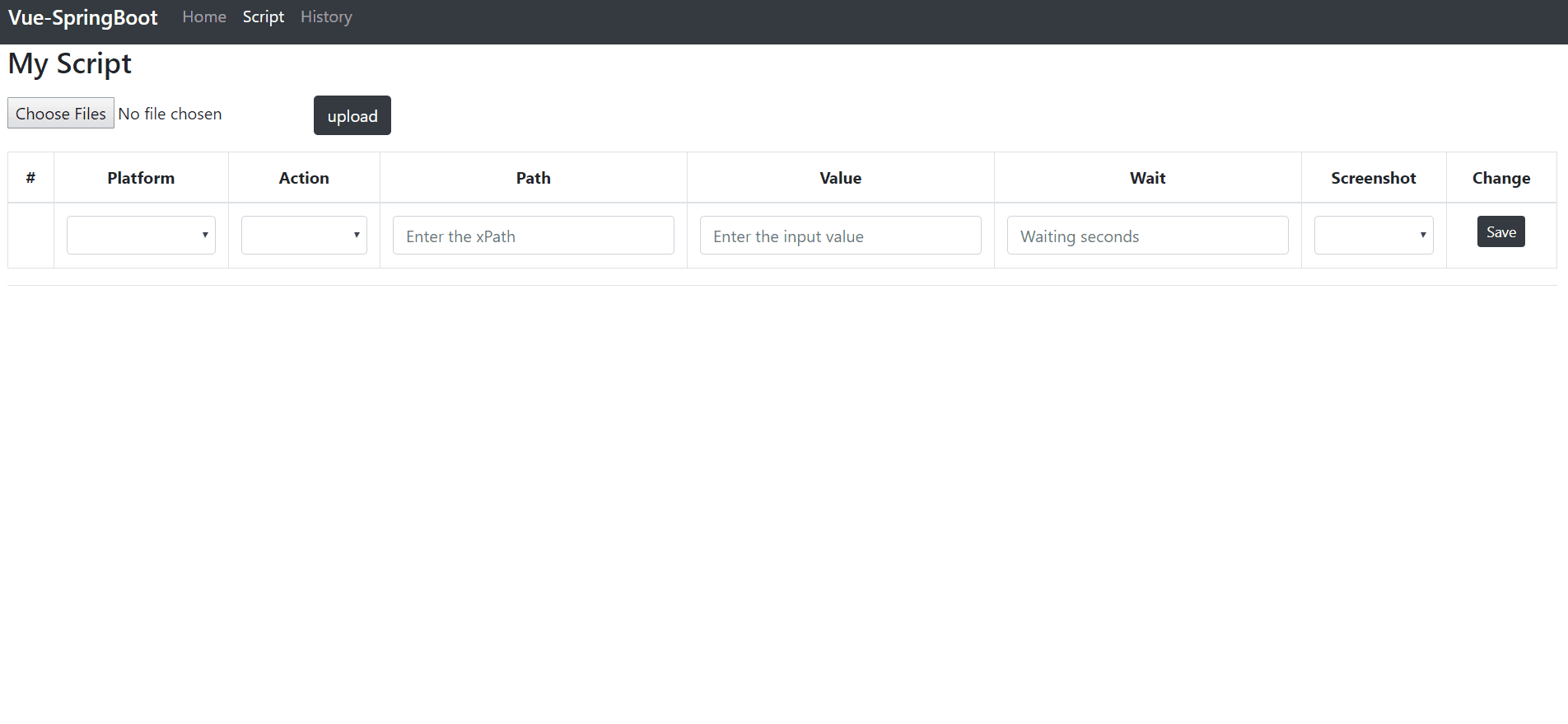
至此,本文相关的纯前端部分完成地差不多了,加上mock的数据后,我们可以开始进行后端的开发了。
4.使用Spring Initializr创建后端项目
为了更轻松地构建工程,构建RESTful API以及更轻松地配置请求处理,笔者选择了Spring Boot作为后端框架。
4.1 首先我们使用IDEA集成的Spring Initializr来构建项目,部分配置如图:
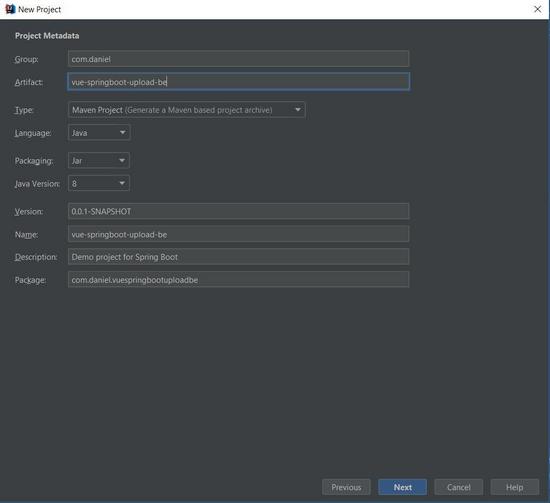

4.2 接下来在pom.xml中引入poi依赖,点击import change。如下所示:
<dependency> <groupId>org.apache.poi</groupId> <artifactId>poi-ooxml</artifactId> <version>4.0.0</version> </dependency>
4.3 接下来我们在application.properties中配置server.port=8088,与前端项目分开
5.pojo类Step的编写
下面是对pojo类的编写,本文所需的pojo只有Step一种,与前端的table相对应,代码如下:
import lombok.Data;
@Data
public class Step {
private String platform;
private String action;
private String path;
private String value;
private int wait;
private String screenshot;
}
6.UploadController的编写
接下来是对前端Post请求的Handler(Controller)进行编写,我们将上传这个Post请求与"/uploadfile"相对应,注意加入@CrossOrigin注解实现跨域,代码如下:
package com.daniel.vuespringbootuploadbe;
import org.springframework.beans.factory.annotation.Autowired;
import org.springframework.stereotype.Controller;
import org.springframework.web.bind.annotation.CrossOrigin;
import org.springframework.web.bind.annotation.PostMapping;
import org.springframework.web.bind.annotation.ResponseBody;
import org.springframework.web.multipart.MultipartFile;
import java.io.File;
import java.io.IOException;
import java.nio.file.Files;
import java.nio.file.Path;
import java.nio.file.Paths;
import java.util.List;
@Controller
@CrossOrigin
@ResponseBody
public class UploadController {
private static String UPLOADED_FOLDER = "src/main/resources/static/temp/";
@Autowired
private LoadService loadService;
@PostMapping("/upload")
public List<Step> singleFileUpload(MultipartFile file) {
try {
// Get the file and save it somewhere
byte[] bytes = file.getBytes();
Path path = Paths.get(UPLOADED_FOLDER + file.getOriginalFilename());
Files.write(path, bytes);
} catch (IOException e) {
e.printStackTrace();
}
// Print file data to html
List<Step> result = loadService.castToStep(new File(UPLOADED_FOLDER + file.getOriginalFilename()));
return result;
}
}
7.LoadService的编写
下面该编写Service来读取请求中传送的文件了,简单地来说只有一个步骤,将Excel中的Script转换为pojo的链表并在Controller中作为ResponseBody返回.
7.1 首先创建Service接口,代码如下:
package com.daniel.vuespringbootuploadbe;
import org.springframework.stereotype.Service;
import java.io.File;
import java.util.List;
@Service
public interface LoadService {
List<Step> castToStep(File file);
}
7.2 接下来创建Service实现类,代码如下:
package com.daniel.vuespringbootuploadbe;
import org.apache.poi.openxml4j.exceptions.InvalidFormatException;
import org.apache.poi.ss.usermodel.Row;
import org.apache.poi.ss.usermodel.Sheet;
import org.apache.poi.ss.usermodel.Workbook;
import org.apache.poi.xssf.usermodel.XSSFWorkbook;
import org.springframework.stereotype.Service;
import java.io.File;
import java.io.IOException;
import java.util.ArrayList;
import java.util.List;
@Service
public class LoadServiceImpl implements LoadService {
@Override
public List<Step> castToStep(File file) {
List<Step> steps = new ArrayList<>();
Workbook workbook = null;
try {
workbook = new XSSFWorkbook(file);
} catch (IOException e) {
e.printStackTrace();
} catch (InvalidFormatException e) {
e.printStackTrace();
}
Sheet sheet = workbook.getSheetAt(0);
int num = sheet.getLastRowNum() - sheet.getFirstRowNum();
//Read steps
for (int i = 0; i < num; i++) {
Row row = sheet.getRow(i+1);
Step step = new Step();
step.setPlatform(row.getCell(0).getStringCellValue());
step.setAction(row.getCell(1).getStringCellValue());
step.setPath(row.getCell(2).getStringCellValue());
step.setValue(row.getCell(3).getStringCellValue());
step.setWait((int) row.getCell(4).getNumericCellValue());
step.setScreenshot(row.getCell(5).getStringCellValue());
steps.add(step);
}
try {
workbook.close();
} catch (IOException e) {
e.printStackTrace();
}
return steps;
}
}
8.搭建简单的RESTful API
文章临近尾声,现在前后端的独立代码基本开发完毕,是时候搭建RESTful了,本文中的API非常简单,就是对上传做出响应,并将返回的json写入界面上的Table中,完成Script导入,npm安装axios后,在ScriptTable组件中加入如下代码:
getFile: function (event) {
this.file = event.target.files[0];
console.log(this.file);
},
submit: function (event) {
event.preventDefault();
let formData = new FormData();
formData.append("file", this.file);
axios.post('http://localhost:8088/upload', formData)
.then(function (response) {
for (let i = 0; i < response.data.length; i++) {
var tempData = {
platform: response.data[i].platform,
action: response.data[i].action,
path: response.data[i].path,
value: response.data[i].value,
wait: response.data[i].wait,
screenshot: response.data[i].screenshot
};
this.steps.push(tempData);
}
}.bind(this))
.catch(function (error) {
alert("Fail");
console.log(error);
});
}
9.运行服务,编写Script并上传
接下来我们创建一个Excel,按如图格式编写简单Script,运行前后端服务,实现上传:
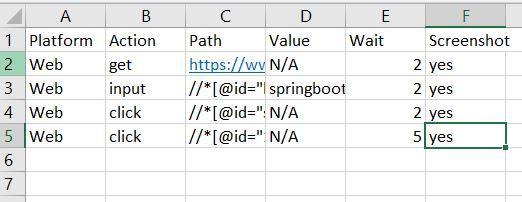
运行后,Excel文件会上传到后端工程的static的temp目录中
总结
以上所述是小编给大家介绍的使用Vue+Spring Boot实现Excel上传功能,希望对大家有所帮助,如果大家有任何疑问请给我留言,小编会及时回复大家的。在此也非常感谢大家对网站的支持!
加载全部内容